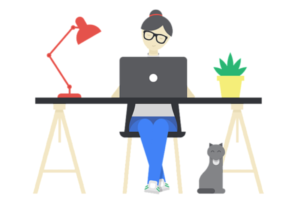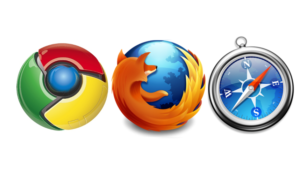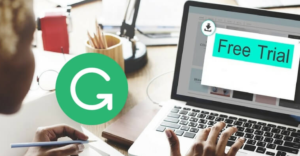Grammarly Review 2017
Table of Contents
By now, I think we are all aware of the classic gag:
- Let’s eat Grandma.
- Let’s eat, Grandma.
“Punctuation saves lives!”
Well, it doesn’t stop at punctuation, I am afraid. The same can be said for grammar. Sometimes, without proper grammar, a sentence can lose its entire meaning. I suppose this is true to all languages, but it is grammar of the English language which I am singling out.
Why do I insist on differentiating English from all other languages? Because, like it or not, it is now an internationally-spoken language. It is the standard used in industry, science, academia, business, and a hundred other fields.
Over its many years of existence, English has gone through many changes:
- Old English, which traces its roots all the way to 5th century BCE!
- Middle English, which was spoken for several hundred years, between the 11th century and the 15th century.
- Modern English, which was spoken since the 15-16th centuries. Right up to…
- Contemporary “Post-Modern” English which is spoken nowadays.
English is a language whose laws can be very difficult to grasp, and this is especially true for those who are studying it as a foreign language. Part of what makes English so annoying and frustrating is the fact that its grammatical laws are also based on remnants of the older incarnations of the English language. Granted, it is a linguistic “mish mash”. Nevertheless, it is an important and highly useful mish mash.
So, why is grammar important? Because English is important. It is a skill which is a leg-up in many walks of life, and it open many doors and possibilities, be it professionally or personally.
It is important, because knowing how to spell, how to punctuate, how to phrase, how to build a sentence, and how communicate properly within this internationally-spoken language is paramount.
“Oh yeah yeah. I process. People want the processing, I’m the one they call.”
- Joey Tribbiani, Friends
There are many word processors out there. It doesn’t all begin and end with Microsoft Word, you know. A word processor is used to type, to format, give a unified style to the information, and essentially build documents of all sorts and kinds.
A grammar-checker, also known as writing enhancement software, is a software which complements – though not necessarily replaces – a word processor. In the case of Microsoft Word, Corel WordPerfect, and many similar programs, there is a built-in spelling and grammar tool. But alas, these are usually not as accurate as they should be. While they may alert the user to more basic mistakes, they lack the programming related to context, style, and continuity, all of which help to generate a more cohesive and understandable text.
One such writing enhancer, which boasts impressive numbers, and claims to be the most accurate one in the world is Grammarly, created by Grammarly Incorporated. It is a program designed to not only correct grammar, but aid the writer in gaining a stronger command of the English language.
What is Grammarly?
 The Grammarly Editor, commonly known as Grammarly, was launched in 2009. It was created by Grammarly, Inc., which was founded in 2008 by two individuals: Alex Shevchenko and Max Lytvyn.
The Grammarly Editor, commonly known as Grammarly, was launched in 2009. It was created by Grammarly, Inc., which was founded in 2008 by two individuals: Alex Shevchenko and Max Lytvyn.
Before co-founding Grammarly, Inc., Shevchenko and Lytvyn were into different projects related to education. They co-created MyDropBox – education software which enables students to exchange files with an instructor. MyDropBox was later acquired by Blackboard, Inc.
These days, the duo continues to manage product development and strategy for Grammarly, and makes sure the company keeps marching forward.
Grammarly holds offices in many locations, including San Francisco, CA, and Kiev, Ukraine. The head of the company’s is Brad Hoover, who joined the team in 2011. Hoover was interested in a software to assist him with his own writing, and came across Grammarly.
Without a doubt, Grammarly’s most popular product is its cloud-based writing platform, which goes by the name same.
Grammarly Editor Explained
 So, what were Shevchenko and Lytvyn trying to achieve when they created Grammarly? Well, let’s put it this way. By 2008, there were already plenty of grammar checkers around. The thing is, the founders were not satisfied with any of them.
So, what were Shevchenko and Lytvyn trying to achieve when they created Grammarly? Well, let’s put it this way. By 2008, there were already plenty of grammar checkers around. The thing is, the founders were not satisfied with any of them.
They sought to create a program which would act as a kind of bridge, and help to fill the gaps between native speakers and non-native speakers. Not only that, but they were looking to create an intuitive program which utilizes advanced algorithms, meant not only to fix errors, but also to improve the user’s English-writing skills.
The Grammarly Editor is an independent, web-based platform. As long as you have a good connection to the internet, you will be able to log on and continue your writing, be it from a tablet, a laptop, a desktop computer, or even your mobile phone. You can sign up for free, and use the Editor as you please. There is a free version and a paid (premium) version.
The Editor is programmed to adhere to over 250 grammatical errors, make the user aware of alternate phrasings and synonyms, and even detect plagiarism or prompt citations when needed. This cloud application checks your spelling, your punctuation, your sentence structure, and your style. This is a program which is used by millions of people, every day, and with good reason.
Grammarly Browser Checker Explained
 Since it is an online application, Grammarly also offers a free browser extension for Chrome, Safari, and Firefox. A lot of our daily communication is done online, so adding a grammar and spelling checker to your web browser is an easy way to ensure your posts, tweets, emails, etc., are all in order. As you type in a textbox, mistakes will be underlined for inspection. The writer may then choose to accept or reject the extension’s suggestions.
Since it is an online application, Grammarly also offers a free browser extension for Chrome, Safari, and Firefox. A lot of our daily communication is done online, so adding a grammar and spelling checker to your web browser is an easy way to ensure your posts, tweets, emails, etc., are all in order. As you type in a textbox, mistakes will be underlined for inspection. The writer may then choose to accept or reject the extension’s suggestions.
The browser checker is a handy little add-on. It takes a few seconds to attach, and then you are pretty much covered. For those who have paid subscriptions to Grammarly, there are more options and features available. But don’t worry! Those who choose to take advantage of the free platform and extension are not left with nothing. Grammarly’s non-premium tools are powerful and useful on their own merit.
Grammarly Microsoft Add-In Explained
 Okay, so obviously the most popular word processor out there is Microsoft Word, which is part of the Office suite. According to Microsoft’s figures, one-in-seven people use Office products. That is over a billion people, easily. Impressive, to say the least. But just because Word is the most popular word processor, does not necessarily make it the best.
Okay, so obviously the most popular word processor out there is Microsoft Word, which is part of the Office suite. According to Microsoft’s figures, one-in-seven people use Office products. That is over a billion people, easily. Impressive, to say the least. But just because Word is the most popular word processor, does not necessarily make it the best.
In fact, when it comes to grammar and spelling, it is far from perfect.
I love Microsoft Word as a processor. It does an excellent job with documents, texts, images, PDFs, fonts and styles. I have no issues with it as a processor and formatter, but it could use some help with its grammar, syntax, and spelling checkers. This is precisely where Grammarly’s Microsoft Office add-on comes in. Unlike the Editor, it is a program which is downloaded and integrated into Office.
In other words, Grammarly will now be at your service as you type away in Outlook and Word, making sure that your text is 100% accurate. Well, no, I take that back. Nothing is 100%. Not even the most advanced writing software will ever be able to come close to the power and accuracy of an educated and acute human observer.
Grammarly’s products act as a digital editor of sorts. As close as possible to another pair of eyes, surveying your words and making suggestions. But they should be treated as a backup, and not necessarily as a fail-safe.The real fail-safe out there is you! And as you use Grammarly, you will undoubtedly become more confident in your abilities.
Other Services Offered by Grammarly
Grammarly’s website offers several services outside of its Editor platform.
Among those services are:
Grammarly@EDU – a sister platform of the original Grammarly website. It was designed as a web-based application which is tailored specifically for the needs of students, teachers, and faculty. Essentially, it is a grammar tutor and revision tool, and it has many users all of over the world. Ranging from individuals to entire campuses, @EDU offers special rates for those who are eligible for registration.
The Handbook – a writing and grammar handbook that covers English grammar, style, and word choice issues. With this guide, you won’t have to think of what to write, when, and how. Think of it as a kind of standard, a writer’s code. There are several such guides out there, though, so it is not as if this guide is the final word on anything. It simply allows you to continue writing, without getting stuck. If you are unsure of how to phrase something or write it (for instance, numbers: letters or numerals?), check out the handbook.
The Blog – an educational blog which doesn’t take itself too seriously. It is full of entertaining posts and thought-out articles on English, education, grammar, words, and writing in general.
It is also a place where users of Grammarly can be brought up to speed on the goingson within the program and the company. Changes in senior staff, new features, and other bits of information, are related to the users via the blog.
Here's some low-hanging fruit for your next sync. #quiz https://t.co/1DIaQaXbWt
— Grammarly (@Grammarly) October 11, 2017
Words – an online dictionary and thesaurus, which is optimized to fit context. It isn’t perfect, but it is useful. The context-optimization is crucial! Using a thesaurus and dictionary can potentially do more harm than good, if you go about it the wrong way. For instance, if you were to use the thesaurus on every single word in your text, the end result would be a horrendous mess.
Answers – a Q&A area for those who wish to consult with Grammarly’s team of linguistic experts on issues of grammar, style, and vocabulary. Examples of recent submissions to the Answers section:
“Non-restrictive of relative pronouns”, “The correct grammatical usage of xmen”, and “Active voice to passive voice”.
Grammarly cares about education and about language. This is why the company has set up this network of related sections. I feel it shows integrity, ingenuity, and a strong desire to put theory into practice, while keeping in touch with their users around the globe.
Grammarly Free + Trial Offer
 Earlier, I mentioned there is a free version of Grammarly, and I will go into some depth about it now. I think I am correct in assuming that Grammarly’s free version is the more popular one. For a free piece of software, it does one heck of a job, and it is no wonder that its reach continues to extend, unabated. Like I said, it has millions of users.
Earlier, I mentioned there is a free version of Grammarly, and I will go into some depth about it now. I think I am correct in assuming that Grammarly’s free version is the more popular one. For a free piece of software, it does one heck of a job, and it is no wonder that its reach continues to extend, unabated. Like I said, it has millions of users.
That being said, the free version does have its drawbacks. First off, it checks spelling and grammar, yes, but it is incomplete in its analysis. There is no checking of advanced grammatical errors, nor of genre, style, and sentence structure.
Second, and this is a big one, there is no plagiarism checker included. For those of us who are using a writing enhancer for academic studies, this could be a good reason to upgrade to the premium version. Ease of mind counts for a lot.
Third, the Microsoft Office add-on is not available. This could be less of an issue. It wasn’t such an issue for me, personally, but I can also see how it can improve a person’s workstation in a big way.
Those additional features are all available for premium subscribers.
Trial offer: Grammarly has a seven-day money-back guarantee for its premium plan.
Get a paid subscription, and use it up to seven days. Don’t like it? Cancel your subscription, and get your money back. But there is a good chance you will be satisfied with the program’s performance, as we will demonstrate in the next section.
Grammarly Premium Explained
 Grammarly keeps on ranking high in all of those “best of” and “top 10” lists of writing enhancers. To quote Forbes magazine: “Grammarly quickly and easily makes your writing better”. And more than that – it makes your writing better, because you become a better writer through it!
Grammarly keeps on ranking high in all of those “best of” and “top 10” lists of writing enhancers. To quote Forbes magazine: “Grammarly quickly and easily makes your writing better”. And more than that – it makes your writing better, because you become a better writer through it!
Unlike the free version, which only provides the user with Grammarly’s basic features, a premium subscription allows the writer to witness the firepower of this fully-armed and operational writing battlestation. Over 250 grammatical points will be checked. A variety of templates are at the user’s disposal. It allows the writer to select a specific genre, such as business, academic, creative, etc. Style and sentence-structure checking are also available, along with vocabulary enhancements and a dictionary and thesaurus. And to top it off, it scores and grades your text according to your specifications. Truly, a powerhouse of possibilities are at your fingertips, when you work with Grammarly premium.
As for cost, Grammarly offers a monthly, quarterly, and annual payment plan. Again, those who are with @EDU will probably be able to get better rates. Also, there are sales and coupon codes, so be sure to do some research and pay less!
As of mid-2017, the cost of a monthly plan is $29.95 a month. Quarterly, $19.98 per month. Annual, $11.66 per month.
My Personal Grammarly Review: The Best Grammar Checker Software
 I want to get this out of the way now: this is my opinion. Different people use different programs to write with. You need to ask yourself, which is the right one for me? Some grammar checkers are geared more towards foreigners. Some are meant to be used more by native speakers. And what of Australian, or British, or South African users? Grammarly does support British spelling, but not the others. Do you see what I am getting at? I found grammarly to do a great job, but you may not. Every piece of software has faults. For me, and my needs? Grammarly has proven to be the best.
I want to get this out of the way now: this is my opinion. Different people use different programs to write with. You need to ask yourself, which is the right one for me? Some grammar checkers are geared more towards foreigners. Some are meant to be used more by native speakers. And what of Australian, or British, or South African users? Grammarly does support British spelling, but not the others. Do you see what I am getting at? I found grammarly to do a great job, but you may not. Every piece of software has faults. For me, and my needs? Grammarly has proven to be the best.
I had the opportunity to try others, such as WhiteSmoke, Ginger, StyleWriter, and several others. This was done over the course of many months, and while those others do a good job, overall I feel Grammarly did the best job.
The program works a lot like Google Docs. Log in, and everything is there on your dashboard. You may continue working on any texts that were there when you last logged off.
My own personal experiences with Grammarly have been good ones. I learned new words, and in time incorporated them into my speech and text. The synonym selection is a great feature. I feel the quality of my writing has improved overall, and this was my main goal. Knowing how to write is one thing, knowing how to write well is quite another. I had good English when I started using Grammarly, but this took it up a notch. It taught me to look out for things I wouldn’t necessarily have bothered to do. It is akin to putting a final finish on an already spiffy-looking wine glass. Or perhaps something less pretentious…?
Grammarly vs. Whitesmoke
 Without a doubt, Grammarly’s fiercest competitor is WhiteSmoke. It was released in 2003, and it offers the writer some essential tools: spell checking, grammar checking, style and syntax correction, a dictionary, a thesaurus, a translator, and other features. It is available in a web-based version, a desktop version, and as a mobile app. It has a more context-based approach to its suggestions, and even though it is different from Grammarly, in some ways it is equally good.
Without a doubt, Grammarly’s fiercest competitor is WhiteSmoke. It was released in 2003, and it offers the writer some essential tools: spell checking, grammar checking, style and syntax correction, a dictionary, a thesaurus, a translator, and other features. It is available in a web-based version, a desktop version, and as a mobile app. It has a more context-based approach to its suggestions, and even though it is different from Grammarly, in some ways it is equally good.
Both Grammarly and WhiteSmoke do a fine job of cleaning up text, but I have to give the edge to Grammarly, since it seems to be more on point with grammatical details like passive voice, correct use of modifiers, adjectives, and verbs. Slang and vernacular can prove to be an issue with any program you choose!
Both platforms come with a plagiarism checker, a dictionary, and a thesaurus. WhiteSmoke has more templates to choose from, and that makes some jobs significantly easier and more manageable.
WhiteSmoke also has an 11-language translator – not great for entire documents, but good for when a text is peppered with foreign words.
I do believe that WhiteSmoke, being more about the context, has the potential to “decipher” more complex pieces of text, but I enjoy Grammarly’s interface more. I have written texts with both of these, and I would use them both again, but if I had to make a choice – and I did – I feel Grammarly is the better of the two. Your mileage may vary.
Future of Grammarly
So, what does the future hold for Grammarly? Well, its most recent blog post was “5 Tips for Avoiding Work on Your Vacation!”, so I guess things are looking pretty good for them. What I can tell you with some certainty, is that this program is here to stay. It has been around for almost a decade, it is improved constantly, and it is gaining new users every day. I’ve said this before: it may not be perfect, but it comes close!
Writing English with confidence is a skill, and it is one which many of us want to acquire. This is what Grammarly offers its users. It is not just about making sure that the emails, posts, tweets, reports, and assignments we send out or hand in are error-free. It is about helping us improve our abilities and push our boundaries. Language is such a wide and broad concept, after all.
Some people are good writers by nature. It is something they can do, at the drop of a hat. But this is not about natural talent. This is about teaching your brain new tricks. And I personally feel anything having to do with language is a trick worth learning. Looking to become a better writer? Read a lot, write a lot, and head over to Grammarly’s website.
https://youtu.be/fVbE2CSXCJ0
No comments yet.